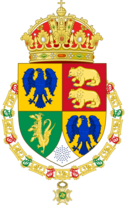Great Council of Belfras
This article is incomplete because it is pending further input from participants, or it is a work-in-progress by one author. Please comment on this article's talk page to share your input, comments and questions. Note: To contribute to this article, you may need to seek help from the author(s) of this page. |
| This article is part of a series on the |
| Politics of Belfras |
|---|
 |
The Great Council of Belfras, simply known as the Great Council is a body of advisors to the Sovereign of Belfras. It is comprised of a collection of councils, committees and boards staffed by members of the nobility and elected government officials with the collective purpose of forming legislation for the country under the guidance and approval of the reigning monarch of the country, who presides over the highest level of government as the chief executive. The Great Council is the modern version of the Imperial Council of the Belfrasian Dependencies under the rulership of the Latin Empire, which ruled over Belfras for 640 years. The extensive history between the two nations are noticeable with the Federation utilising what it calls the 'Latin Imperial Model' for a number of government bodies, including the nations structure of nobility.
It is the duty of the Great Council to, as well as form legislation, advise the sovereign on matters of state and international relations. The primary body of the council is the Cabinet, which is the primary decision-making body of government and is headed by the sovereign, the lord chamberlain and the elected Consul. The cabinet is split in two levels; A selection of ministers, appointed by the sovereign, are in charge of their ministries (eg: Ministry of Defence). The second is an appointment of State Secretaries chosen by the Consul and approved by the sovereign from the Consuls party. The State Secretaries take up sections of their ministries portfolios, such as the State Secretary of Defence who is responsible for equipment and personnel policy. While State Secretaries must be members of the senate, ministers are not required to be and are freely appointed by the sovereign by their right as the head of state and chief executive.
A number of committees, boards and councils act subordinate to these two primary decision-making bodies and are capable of issuing advise or writs of notice that can alter or propose new legislation for approval. The Royal Investigation Board, responsible for leading investigations required by the Sovereign or Consul into matters of great import, is a part of the Great Council. The Royal Investigation Board came to be known by the greater public following it's investigation into the devastating 1993 Orestes Terror Attack.
The Cabinet
The Cabinet of Belfras is the main executive body of Belfras and is made up of two bodies; The Sovereigns Assembly and the Council of Magistrates. The Sovereign Prince in their duty as head of state and chief executive is the head of the cabinet which acts on their behalf. The Sovereign personally appoints ministers and appointees to the Assembly which is the higher of the two bodies and requires no approval for appointments, although often discusses potential appointments with the Royal Chancellor and the Consul. While most appointments to the Assembly are heads of the Sovereigns ministries, some are appointed due to their position in other bodies (such as the Chief of the Military Council) and some, such as the Royal Chancellor, are selected due to their relationship with the Sovereign and ability to act as a chief advisor in their field.
Serving the Assembly is the second of the two bodies, the Council of Magistrates. The head of this council is the Consul, the most senior elected official and who leads the senate on the Sovereigns behalf. The Council is primarily made up of the Praetors, whos Praetorships reside in the ministries led by members of the Assembly. These Praetorships are established to have a set portfolio of responsibilities within their ministry and report to their respective minister who, in turn, reports to the sovereign. While none of these offices have a set term or a limit of terms, they rely on two factors. The Ministers rely on having the confidence of the sovereign in their position and may be replaced at the Sovereigns discretion. Praetors require both the confidence of their minister and the people, as almost all Praetors to have sit in office have been from the leading party in the senate.
The Sovereigns Assembly
Main Article: The Sovereigns Assembly
The Council of Magistrates
Main Article: The Council of Magistrates
Committees
Court of the Royal Mint
The Court of the Royal Mint is a unitary board that is responsible for setting the strategy of business and budget of the Royal Mint, the country's central bank and money printer. It is composed of seven executive members of the bank and ten non-executive members who typically are either heads of other major banks or appointed by the sovereign. It is headed by the Lord Governor of the Royal Mint, who in turn appoints two deputy governors to enable the smooth operation of the bank. The Current Lord Governor is Prince Sergios, who has held the position since 2000.
Royal Investigative Committee
A non-permanent position, the Royal Investigation Committee is set up to consider and report on petitions or to command investigations into matters of state in order to recommend to the sovereign changes to laws or national policy. Members of the Royal Investigative Committee depend on recommendations by the Consul, the Lord Advisory Council, and appointment by the sovereign. Despite the recommendations, the committee does not answer to any other part of the Great Council and is instead solely responsible to the sovereign. Some previous instances include:
- The Zoilus Committee - Set up by Charles Zoilus by the sovereign in 1992 to lead the investigation into the 1992 Orestes Terror Attack




